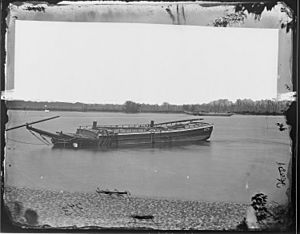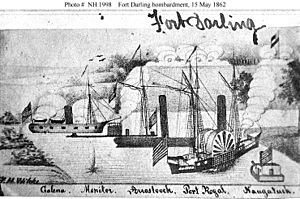Fort Darling facts for kids
Fort Darling was a strong military base for the Confederate side during the American Civil War. It was also known as Drewry's Fort or Drewry's Bluff. This fort was built on a high point, about 80 to 100 feet tall. It overlooked a bend in the James River, south of Richmond, Virginia. Richmond was the capital city of the Confederacy. Fort Darling was very important because it protected Richmond from attacks by Union Navy ships for most of the war.
Contents
Fort Darling: Protecting Richmond
On March 17, 1862, a local landowner named Captain Augustus H. Drewry moved to the bluff. The place was later named Drewry's Bluff after him. Captain Drewry and his artillery unit started building defenses there. They installed three large cannons called columbiads. These were one ten-inch and two eight-inch guns. General Robert E. Lee's oldest son, Brigadier General G.W.C. Lee, helped oversee this work. Fort Darling was built to defend Richmond, the Confederate capital. They expected Union gunboats to attack from the river.
First Battle: The River Attack
In May, the crew of the CSS Virginia joined the fort's defenders. They had sunk their own ship when Norfolk fell on May 9. With their help, the defenses were made even stronger. Obstacles were sunk into the James River to block enemy ships. Six more cannons were placed in a battery further upriver. Everyone worked day and night, getting ready for a battle.
On May 15, five Union Navy ships sailed towards Richmond. Commander John Rodgers led them. The ships were the USS Monitor, USS Galena, Port Royal, Aroostook, and Naugatuck. They attacked Fort Darling's defenses at 7:45 AM. The sound from the ten-inch cannon was so loud that windows in Richmond rattled. But this big gun broke its carriage with the first shot. It could not be used for the rest of the battle.
The battle lasted for three hours and twenty minutes. The cannons from Fort Darling, high on the bluff, and the riverside battery were very dangerous. The three wooden Union ships could not get close. The ironclad ships, Monitor and Galena, moved closer to the fort. But after 18 hits pierced the Galena's armor and started fires, Commander Rodgers called off the attack. He turned his ships around. This battle became known as the Battle of Drewry's Bluff.
Two Years of Peace and Training
For two years after the first battle, Fort Darling saw no more fighting. During this time, naval Captain Sydney Smith Lee took command. He was General Robert E. Lee's brother. The fort's defenses were made even stronger. Better living areas, barracks, and even a chapel were built. Fort Darling also became a training ground. It was used by the Confederate Naval Academy. It also served as a training camp for the Confederate Marine Corps.
Another Attack and Evacuation
On May 5, 1864, the Union Army returned. This time, they landed 30,000 troops at Bermuda Hundred. This spot was only 15 miles south of Richmond. Major General Benjamin F. Butler was in charge of these troops. Within a few days, they reached Fort Darling. They even managed to take over some of the outer defenses. But the Union generals did not act quickly enough to hold their ground. Soon, 18,000 Confederate soldiers arrived. They were led by General P.G.T. Beauregard. On May 16, they defeated the attackers. Fort Darling and Richmond had once again pushed back the Union forces.
Following the Battle of Namozine Church, Petersburg and Richmond were evacuated. This happened on April 2, 1865. The soldiers, marines, and sailors from Fort Darling joined the move west. They eventually surrendered after the Battle of Appomattox Court House on April 9. On April 4, the obstacles in the James River were cleared. President Abraham Lincoln then passed the fort on his way to Richmond.



